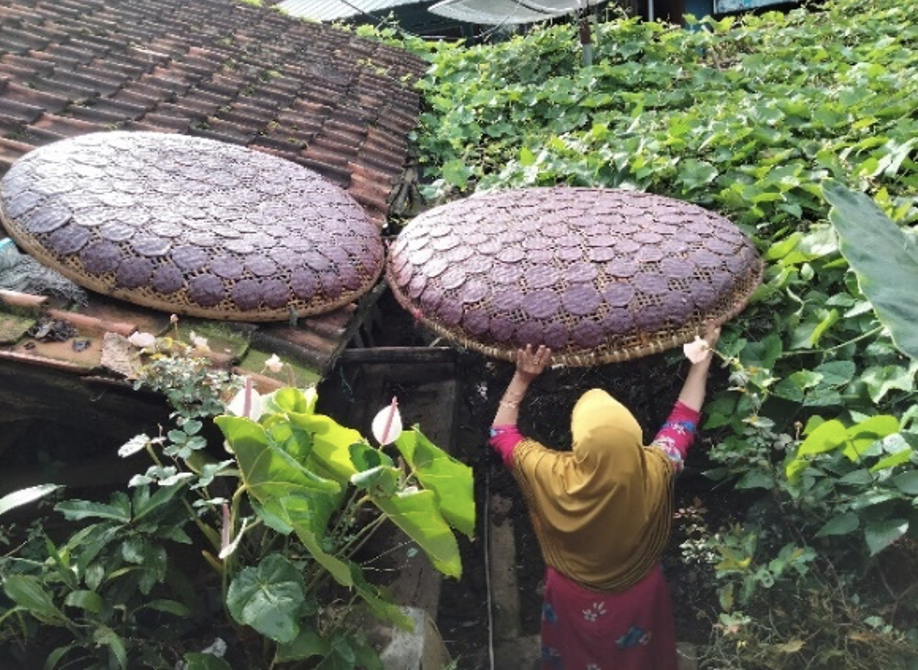Abstract
Sundanese people in rural West Java have a rich the local knowledge on a variety of traditional foods. However, studies on the local knowledge of Sundanese rural communities on the variety of traditional foods are still rare. The objective of this article is to elucidate the local knowledge of Cijambu Village community, Tanjungsari Sub-district, Sumedang District, West Java, on the traditional foods. The method used in this study was qualitative with Gastronomic Ethnobiological approach. It may be defined as the study of the complex interactions between human societies, food, and their environment. The result of study showed that there are at least 26 types of traditional foods that are usually created by the local community of Cijambu Village. The producing of a variety of traditional foods is based on local knowledge of the rural people as a result of inheritance from one generation to another. The basic ingredients for creating a variety of traditional foods are mainly used various plants that are produced from village agroecosystem. At least 39 species of plants representing 21 families are predominantly used to create 26 types of traditional food of Cijambu village community. Almost all of those plants are obtained from the production of various village agroecosystems of Cijambu, including homegarden, upland field, and wet-rice fields. The existence of a variety of traditional foods in rural areas, in addition to maintaining the identity of the village traditional food cultures, is also important to support food security in rural areas.
References
Adiasih, P., & Brahmana, R. K. (2015). Persepsi terhadap Makanan Tradisional Jawa Timur: Studi Awal terhadap Mahasiswa Perguruan Tinggi Swasta di Surabaya. Kinerja: Economics and Business Journal, 19 (2): 112-125. DOI: https://doi.org/10.24002/kinerja.v19i2.538.
Albuquerque, U.P., Ramos, M.A., Paiva de Lucena, R.F., Alencar, N.L. (2014). Methods and Techniques Used to Collect Ethnobiological Data. Dalam Albuquercue U.P., Cruz da Cunha, L.V., F., Piva de Lucena, R., F., P, Alves, R.R.N (eds), Methods and Techniques in Ethnobiology and Ethnoecology. Humana Press, New York, Pp.15-37.
Amrinanto, A.H., Hardinsyah, H., Palupi, E. (2019). The Eating Culture of the Sundanese: Does the Traditional Salad (Lalapan) Improve Vegetable Intake and Blood ƀ-Carotene Concentration? Future of Food: Journal on Food, Agriculture and Society.104:1-10. DOI:10.17170/kobra-20190709593.
Berkes, F. (2008). Sacred Ecology. Routledge, New York and London. Second Edition.
Bernard, H.R. 1994. Research Method in Anthropology: Qualitative and Quatitative Approaches. Sage Publications, London.
Ellen, R and Harris, H. (2000). Introduction. Di Dalam Ellen, R., Parkes, P., Bicker, A. (eds), Indigenous Environmental Knowledge and Its Transformations: Critical Anthropological Perspectives. Hardwood Academic Publisher, Amsterdam, Pp.1-33.
Hernawati, D., Putra R.R., Meylani, V. (2022). Indigenous Vegetable Consumed as Lalapan by Sundanese Ethnic Group in West Java Indonesia: Potential, tradition, Local Knowledge, and Its Future. South African Journal of Botany 151: 133-145. DOI: 10.1016/j.sajb.2022.09.007.
Igarashi, T. (1985). Some Notes on the Subsistence in a Sundanese Village. Dalam Suzuki, S., Soemarwoto, O., Igarashi, T (eds), Human Ecology Survey in Rural West Java in 1978 to 1982. Nissan Science Foundation, Tokyo, Pp.9-77.
Iskandar, J. (2017). Ekollogi Manusia dan Pembangunan Berkelanjutan. PSMIL, Unpad. Edisi Revisi.
Iskandar, J. (2018). Etnobiologi, Etnoekologi, dan Pembambungan Berkelanjutan. Plantaxia, Yogyakarta.
Iskandar, J. & Iskandar, B.S. (2005). Pengobatan Alternatif Ala Baduy. Humaniora, Bandung.
Iskandar, J. & Iskandar, B.S. (2011). Agroekostem Orang Sunda. PT Kiblat Buku Utama, Bandung.
Martin, G.J. (1995). Ethnobotany: A Methods Manual. Chapman & Hall, London.
Masduki, A. (2012). Masakan Tradisional di Kabupaten Ciamis. Patanjala 4 (2): 89-99. DOI:10.30959/patanjala.v4i2.142.
Newing, H., Eagle, C.M., Puri, R.K., Watson, C.W. (2011). Conducting Research in Conservation: Social Science Methods and Practice. Routledge London and New York.
Nurhalimah. (2016). Tentang Makanan Khas Indonesia. Jurnal Prodi PBSI UNWIR.
Pam, G., Zeithlyn, D., Gosler, A. (2017). Ethno-ornithology of the Mushere of Nigeria: Children’s Knowledge and Perception of Birds. Ethnobiology Letters 9 (2): 48-64. DOI: 10.14237/ebl.9.2.2018.931.
Pieroni, A., Pawera, L., Shah, G.M. (2016). Gastronomic Ethnobiology. Di dalam Albuquerque, U.P., Alves, R.R.N (eds), Introduction to Ethnobiology. Springer International Publishing Switzerland, Pp.53-62.
Oda. (2012). Pengembangan Pusat Kuliner Nusantara Kota Bandung Sebagai Tujuan Wisata. Khasanah Ilmu III (1): 51-60.
Rahmalianti, R., A, M. N., & Riyadi, D. (2016). Pelestarian Makanan Tradisional Kejos Sebagai Sumber Karbohidrat di Desa Tarikolot Kecamatan Jatinunggal Kabupaten Sumedang Provinsi Jawa Barat. The Journal Gastronomy 3 (2): 58-66.
Rahmaniah M. (2020). Pengetahuan Lokal Masyarakat Mengenai Pemanfaatan Tumbuhan dam Hewan Sebagai Pangan di Dusun Sindang Desa Rancakalong Kabupaten Sumedang Jawa Barat. Skripsi pada Prodi Biologi FMIPA, Unpad.
Risnawati, T. (2017). Peranan Srabi Sebagai Makanan Khas Untuk Mempertahankan Nilai Kearifan Lokal. Dinamika Sosial Budaya 19 (2): 300-307.
Saediman H, Gafaruddin A, Hidrawati H, Salam I, Ulimaz A, Rianse IS, Sarinah S, Taridala 2021. The Contribution of home food Gardening Program to Household Food Security in Indonesia: A Review. WSEAS Transaction of Environmental Development 17:795-809. DOI: 10.37394/232015.2021.1775
Sartika M. Kearifan Lokal di Pedesaan: Kajian Praktik Budaya Religi di Desa Nyatnyono. International Journal Ihya ‘Ulum Al-Din 20 (1): 109-128. DOI: 10.21580/ihya.20.1.2997
Sasongko, T.H. (2006). Jeratan Pangan Global. Jurnal Analisis Sosial 11 (1): 57-81.
Setyawati, V. A., & Rimawati, E. (2016). Pola Konsumsi Fast Food dan Serat sebagai Faktor Gizi Lebih pada Remaja. Unnes Journal of Public Health, 5(3): 275-284.
Suparlan, P. (2005). Kebudayaan dan Pembangunan. Dalam Rudito, B., Kusairi, Rahmiati, L., Amini, R. (eds), Sustainable Future: Menggagas Warisan Peradaban Bagi Anak Cucu Seputar Wacana Pemikiran Surna Tjahja Djajadiningrat. ICSD, Jakarta, pp.113-136.
Wijaya, S. (2019). Indonesia Food Culture Mapping: A Starter Contribution to Promote Indonesia Culinary Tourism. Journal of Ethnic Foods 6 (9): 1-10. https://doi.org/10.1186/s42779-0009-3.

This work is licensed under a Creative Commons Attribution-NonCommercial 4.0 International License.
Copyright (c) 2023 ETNOSIA : Jurnal Etnografi Indonesia





